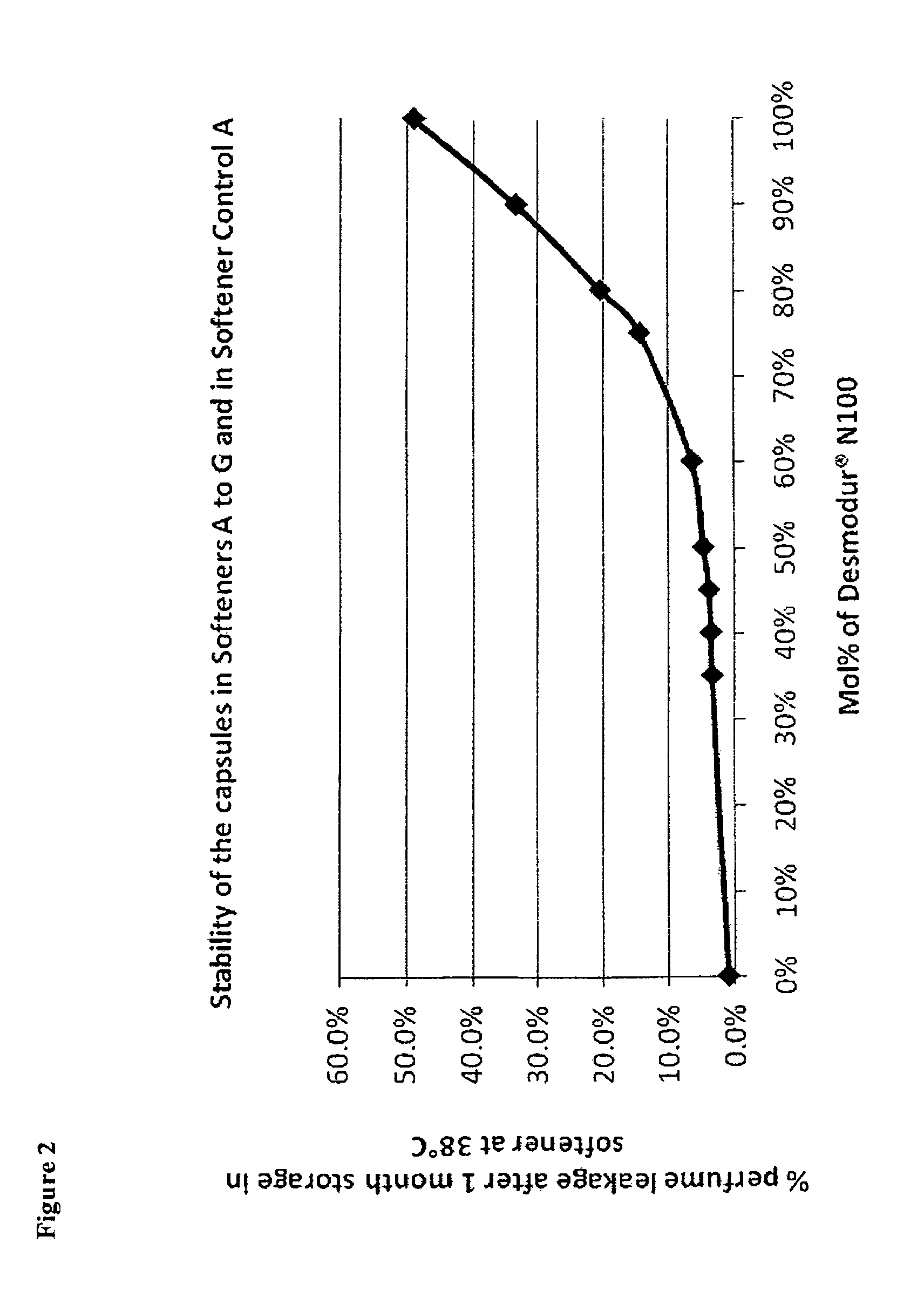Process for preparing polyurea microcapsules
a technology of polyurea and microcapsules, which is applied in the field of preparation of polyurea microcapsules, can solve the problems of odoriferous compound olfactive benefits that are affected by the rapid loss of odor, difficulty in preparing capsules with good olfactive performance, and poor stability of delivery systems
- Summary
- Abstract
- Description
- Claims
- Application Information
AI Technical Summary
Benefits of technology
Problems solved by technology
Method used
Image
Examples
example 1
Preparation of Polyurea Microcapsules of the Invention
[0055]Polyurea microcapsules according to the invention (Capsules A) were prepared having the following ingredients:
[0056]
TABLE 1Composition of Capsules AMolar percentage,relative to totalIngredientAmount [g]polyisocyanateDesmodur ® N 1001)21.480Takenate ® D-110N2)10.220Perfume3)400.0Polyvinyl alcohol4)5.5Tetraethyl ammonium chloride5)4.0Guanidine carbonate6)9.0Water562.51)Biuret of hexamethylene diisocyanate, origin: Bayer2)Trimethylol propane-adduct of xylylene diisocyanate, origin: Mitsui Chemicals3)Perfuming composition having the ingredients of Table 1a4)Mowiol ® 18-88, origin: Fluka5)Tetraethyl ammonium chloride (50% aqueous solution), origin: Fluka6)Origin: Acros Organics
[0057]
TABLE 1a) Composition of the perfumeIngredientLogPAmount [%]Allyl (cyclohexyloxy)-acetatea)2.721.22,4-Dimethyl-3-cyclohexene-1-carbaldehydeb)2.851.2Menthone2.871.7Hedione ®c)2.985.8Camphor3.042.9Eucalyptol3.135.8Dihydromyrcenold)3.4711.5Rose oxyde3.5...
example 2
Preparation of Polyurea Microcapsules of the Invention
[0064]Capsules B to G were prepared using the method described in Example 1. There were used the same amounts of perfume, polyvinyl alcohol, tetraethyl ammonium chloride, guanidine carbonate and water, as in Table 1. Only the amounts of Desmodur® N 100 and Takenate® 110N varied, as indicated in the table below.
[0065]
TABLE 2Amounts of polyisocyanates in Capsules B to GDesmodur ® N 1001)Takenate ® D-110N2)Mol %, relativeMol %, relativeAmountto totalAmountto total[g]polyisocyanate[g]polyisocyanateCapsules B20.07512.825Capsules C16.06020.540Capsules D13.45025.650Capsules E12.04528.155Capsules F10.74030.760Capsules G9.43533.2651)Biuret of hexamethylene diisocyanate, origin: Bayer2)Trimethylol propane-adduct of xylylene diisocyanate, origin: Mitsui Chemicals
example 3
Preparation of Polyurea Microcapsules of the Invention
[0066]Capsules H and I were prepared using the method described in Example 1. There were used the same amounts of perfume, polyvinyl alcohol, tetraethyl ammonium chloride, guanidine carbonate and water, as in Table 1. Only the nature and the amount of the polyisocyanate varied. Takenate® D-110N was replaced by Desmodur® RC in Capsules H and by Desmodur® L75 in Capsules I. The respective amounts of polyisocyanate used in Capsules H and I are summarized in the two tables below.
[0067]
TABLE 3Amount of polyisocyanates in Capsules HDesmodur ® N 1001)Desmodur ® RC2)Mol %, relativeMol %, relativeAmountto totalAmountto total[g]polyisocyanate[g]polyisocyanateCapsules H21.48016.8201)Biuret of hexamethylene diisocyanate, origin: Bayer2)Polyisocyanurate of toluene diisocyanate, origin: Bayer
[0068]
TABLE 4Amount of polyisocyanates in Capsules IDesmodur ® N 1001)Desmodur ® L752)Mol %, relativeMol %, relativeAmountto totalAmountto total[g]polyiso...
PUM
| Property | Measurement | Unit |
|---|---|---|
| diameter | aaaaa | aaaaa |
| diameter | aaaaa | aaaaa |
| diameter | aaaaa | aaaaa |
Abstract
Description
Claims
Application Information
 Login to View More
Login to View More - R&D
- Intellectual Property
- Life Sciences
- Materials
- Tech Scout
- Unparalleled Data Quality
- Higher Quality Content
- 60% Fewer Hallucinations
Browse by: Latest US Patents, China's latest patents, Technical Efficacy Thesaurus, Application Domain, Technology Topic, Popular Technical Reports.
© 2025 PatSnap. All rights reserved.Legal|Privacy policy|Modern Slavery Act Transparency Statement|Sitemap|About US| Contact US: help@patsnap.com


